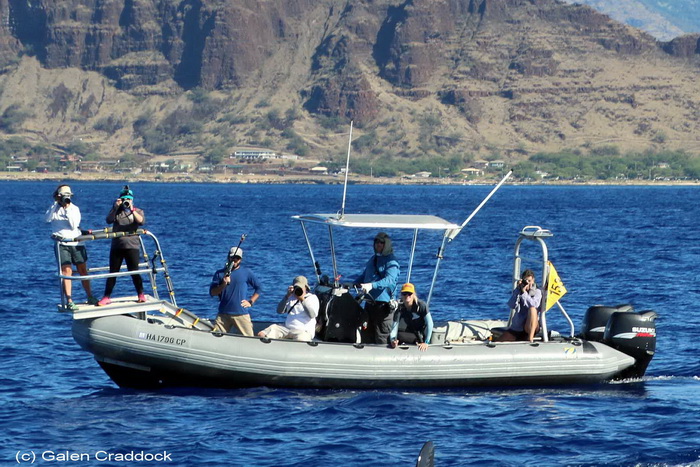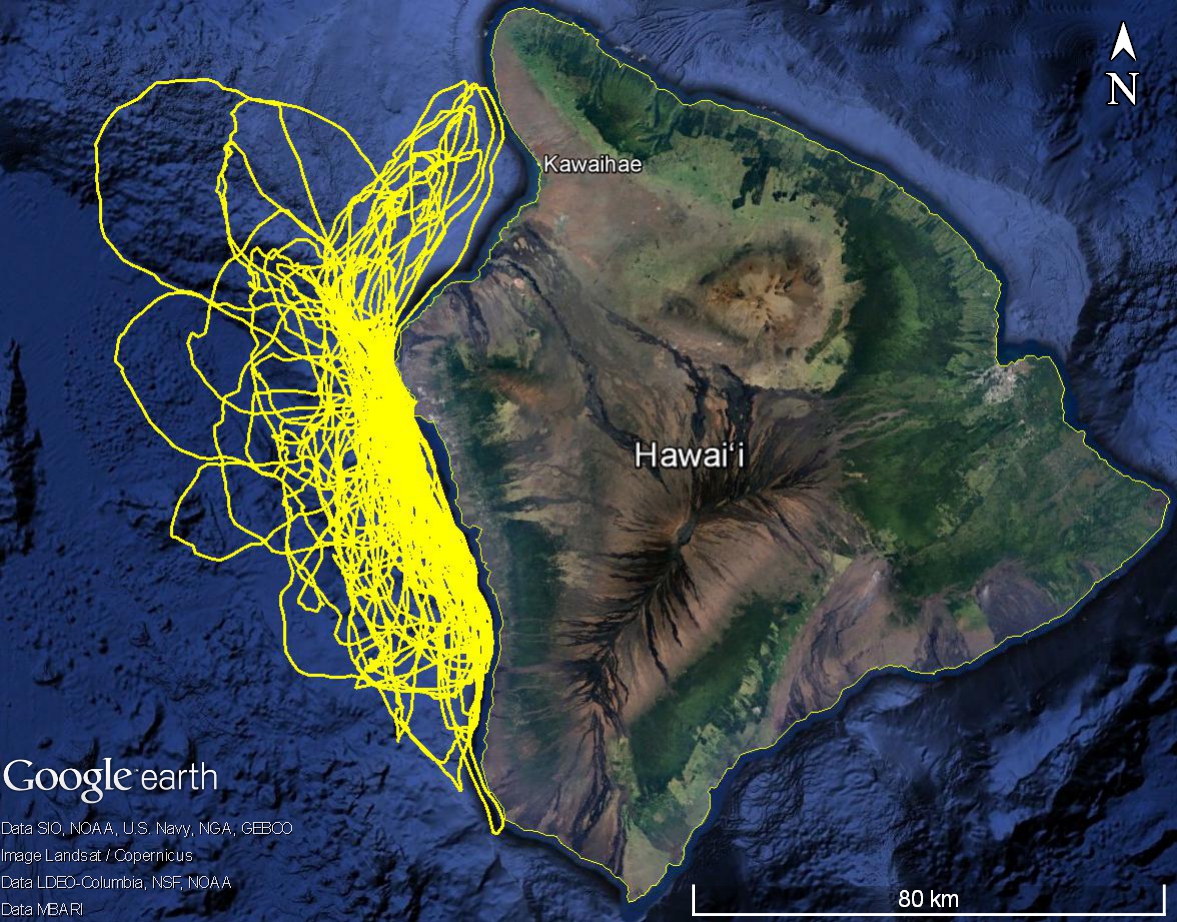We will be undertaking a 10-day field effort off Hawai‘i Island starting October 7th, funded through a NOAA Species Recovery Grant to the State of Hawai’i, with addition support from Dolphin Quest. This will be our second field effort off the “big island” this year (our last was in June). Our primary goal is to find and learn more about the endangered main Hawaiian Islands population of false killer whales, and to maximize our chances of finding them we are planning on launching from Kawaihae each day (see map below), rather than our typical Kona work based out of Honokohau Harbor. The area off Kohala is a high density area for false killer whales in Hawai‘i, particularly the poorly-known Cluster 2. We are hoping to deploy LIMPET satellite tags to track movements, as well as photo-identify individuals and collect biopsy samples for genetics, hormone chemistry and toxicology. As usual, we’ll be working with all species of odontocetes we encounter, trying to obtain photos for our photo-identification catalogs, as well as collect biopsy samples for other studies, and are hoping to deploy one or two satellite tags to track movements of some of the other poorly-known species off the island.
The research crew for this project will include Daniel Webster, Kim Wood, Colin Cornforth and Robin Baird, all from Cascadia, Brittany Guenther, as well as a number of volunteers.
End of project update
While only a 10-day project, it was a very productive one. We covered 1,246 km, most of it off north Kona and Kohala, had 21 encounters with 9 species of whales and dolphins, took over 26,000 photos for individual identification and scarring pattern assessment, collected 8 biopsy samples, and deployed 3 satellite tags, the latter on individuals from the rarely-seen and poorly-known Cluster 2 of the endangered main Hawaiian Islands false killer whale population. Overall a very good project, and we are looking forward to tracking the movements of Cluster 2 over the next few months. Our next field project will start November 2nd off Oahu – check the web page for that project after November 2nd!
October 15th update

The winds have picked up so we have shifted our operations from Kawaihae harbor to Honokohau harbor, allowing us to work in calmer waters to the south. Our three tagged false killer whales have primarily remained on the windward side of the island, so we are not missing those as we survey in deeper waters to the west. Over the last few days we’ve had sightings of spinner, spotted, and bottlenose dolphins, and today had our first encounter with rough-toothed dolphins of the trip. The individual above has a large mahimahi in the mouth – we saw a group of rough-toothed dolphins feeding on three different mahimahi.

We’ve seen rough-toothed dolphins, commonly known off Kona as “Steno”, feeding on mahimahi before but they also feed on a lot of smaller fish, including flying fish. The abundance of fish caught in today’s encounter seemed to encourage them to play and socialize, including this individual leaping out the water (see below).


We also picked up a hagfish that was floating dead at the surface and being fed on by Wedge-tailed Shearwaters. We collected the head of this specimen to send to the Marine Mammal Lab in Seattle for identification, as part of a study on diet of seabirds and marine mammals in Hawai’i.
October 12th update

Our success on these projects usually comes down to one very productive day, and today was that day. We again encountered false killer whales from Cluster 2 of the endangered main Hawaiian Islands population (the third day in a row!), but this time we encountered a fairly large group (~18 individuals) early in the day (9:44 AM) and were able to stay with them most of the day (4:25 PM) in relatively good conditions. We were able to get good identification photos of about 16 individuals, collected six biopsy samples (all from individuals not previously sampled) and deployed three satellite tags. The last time we had such a productive encounter with this cluster was in 2015, and this is only the second time when individuals from Cluster 2 have been satellite tagged, so we are excited about tracking them over the next few weeks and months. The biopsy samples will be used both for genetics and studies of hormone chemistry, to examine stress and reproductive hormones.

One of the Cluster 2 false killer whales seen today.

This adult female, HIPc230 in our photo-ID catalog, was first photographed off the island in July 1987, over 30 years ago, by researcher Dan McSweeney. HIPc230 was adult-sized in 1987, so is at least in her 40s and is likely older. She had the injury on her dorsal fin when first encountered in 1987, likely due to an interaction with longline gear, which was fished close to the islands up until the early 1990s. We use images like this to assess evidence of fisheries interactions, and how it varies among the different social clusters and by sex.
October 11th update

The last couple of days have been very productive, with sightings of false killer whales and melon-headed whales two days in a row, as well as two different groups of pygmy killer whales. The false killer whales, like the one pictured above, are from Cluster 2 of the endangered main Hawaiian Islands population, our primary target species for this trip. We’ve been able to get good ID photos of a number of individuals, but as of October 11th have not been able to deploy any satellite tags. We are hoping they will stay in the area and we’ll have additional opportunities!

This well-marked false killer whale is HIPc150 in our catalog, first documented in September 2002 and last seen in 2016. We’ve never seen this individual with a calf and have not been able to collect a biopsy sample to confirm sex, but based on the size appears to be an adult male.

On October 11th we had two different encounters with one of the rarely and most poorly-known species of delphinid in the world, pygmy killer whales. The photo above shows the belly of one individual witih the white pigmentation around the genital slit and the rounded flippers typical of the species. We were able to get good identification photos of about 30 different individuals in the two groups. There is a resident population of this species around Hawai’i Island and a resident group off Oahu, with some movements between islands, so we are looking forward to matching these photos to our catalog.

The photo above shows the rounded head and white that extends from the lips onto the front of the head, typical of pygmy killer whales.

Pygmy killer whales are very difficult to distinguish from melon-headed whales, another species we saw today (see below), but in good lighting conditions you can see the clear line between the darker dorsal cape and the lighter pigmentation on the side of the body, as well as the frequent paired white linear scars typical for pygmy killer whales.

The melon-headed whales we encountered both days were in relatively shallow water (<1,000 m) on the plateau west of Kohala, and are likely members of the Kohala resident population of this species, numbering around 450 individuals. If you are interested in more information on this species in Hawai’i, we have several recent publications (including genetics and range/habitat use) available on our melon-headed whale page.

This photo of a melon-headed whale also shows the dark facial mask and indistinct boundary between the dorsal cape and lighter sides.

We’ve also collected several squid, now up to four for the trip. These squid are sent to Bill Walker at the Marine Mammal Laboratory in Seattle for identification, helping us understand the prey that are available to whales and dolphins in Hawaiian waters.
October 8th update

In our first three days of effort this trip we’ve covered almost 500 km (480 to be exact) of tracklines off Kohala and north Kona, and surprisingly have only had four sightings of whales or dolphins, well below or average rate. We’ve had reasonably good conditions for much of the time, and yesterday (October 8th) we spent several hours in the ‘Alenuihaha Channel, making it half way between Hawai’i Island and Maui, but have not found our target species, false killer whales. We have had productive encounters however, today with a group of short-finned pilot whales, including the mother and newborn in the photo above, as well as pantropical spotted dolphins and bottlenose dolphins (see below). We’ve also collected two squid specimens, and obtained a few hundred photos of petrels and other seabirds.

A bottlenose dolphin off Kohala, October 8th, 2017

Pantropical spotted dolphins seen October 7th, 2017.

Pantropical spotted dolphins, October 7th, 2017

Our target species for the trip, a false killer whale (accompanied in this photo by two Wedge-tailed Shearwaters). This photo was taken off O’ahu in October 2016 as part of a field project there.

The research vessel we’ll be using for this project, a 24’ Hurricane. Photo by Galen Craddock

This map shows our previous search effort during the month of October. We’ve worked off the island during the month of October in a number of years, most recently in October 2013.
Photos on this page were taken under NMFS ESA/MMPA Permit No. 20605. Please contact Robin Baird (rwbaird (at) cascadiaresearch dot org) for photo use or more information.
For updates from our prior field projects check out this page.